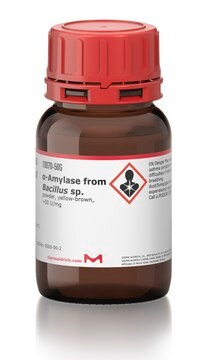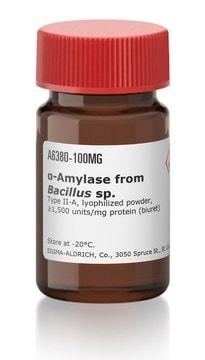10069
α-Amylase from Bacillus sp.
powder, yellow-brown, ~380 U/mg
Autenticatiper visualizzare i prezzi riservati alla tua organizzazione & contrattuali
About This Item
Prodotti consigliati
Origine biologica
Bacillus sp.
Stato
powder
Attività specifica
~380 U/mg
Caratteristiche più verdi
Waste Prevention
Design for Energy Efficiency
Learn more about the Principles of Green Chemistry.
sustainability
Greener Alternative Product
Colore
yellow-brown
Categoria alternativa più verde
, Enabling
Temperatura di conservazione
2-8°C
Cerchi prodotti simili? Visita Guida al confronto tra prodotti
Descrizione generale
α-Amylase (α-1,4-glucan-4-glucanohydrolase) belongs to the glycosyl hydrolase family 13. The two aspartic residues and one glutamic acid residue are the prime catalytic residues of α-amylase. All amylases have three domain regions, namely, domain A with a central (β/α)8 barrel, domain B, and β-structure with a Greek key motif encompassing domain C.
We are committed to bringing you Greener Alternative Products, which adhere to one or more of The 12 Principles of Greener Chemistry. This product has been enhanced for energy efficiency and waste prevention when used in starch hydrolysis research. For more information see the article in biofiles.
Applicazioni
α-Amylase from Bacillus sp. has been used:
- as a dispersal enzyme to test degradation of S. aureus biofilms,
- in the enzymatic hydrolysis of tapioca starch
- in the enzymolysis of plant-based native and the amorphous granular starches
Heat stability of bacterial α-amylasescitation; Action pattern on sweet potato starch, amylose and amylopectincitation; Action on native wheat starch.citation
Azioni biochim/fisiol
α-Amylase mediates the hydrolysis of starch, malto-oligosaccharides, and glycogen at the α-D-(1,4)-glucosidic linkages. Bacillus sp. serve as an important cell factory for the heterogeneous production of α-amylase. An extracellular secreted thermostable amylase from the Bacillus subtilis strain has also been reported.
Definizione di unità
One unit is the amount of enzyme which liberates 1 μmole of maltose per minute at pH 6.9 and 25°C (using Cat. No. 85642 as substrate)
Altre note
Heat stability of bacterial α-amylases; Action pattern on sweet potato starch, amylose and amylopectin; Action on native wheat starch.
Avvertenze
Danger
Indicazioni di pericolo
Consigli di prudenza
Classi di pericolo
Resp. Sens. 1
Codice della classe di stoccaggio
11 - Combustible Solids
Classe di pericolosità dell'acqua (WGK)
WGK 1
Punto d’infiammabilità (°F)
Not applicable
Punto d’infiammabilità (°C)
Not applicable
Dispositivi di protezione individuale
dust mask type N95 (US), Eyeshields, Faceshields, Gloves
Scegli una delle versioni più recenti:
Possiedi già questo prodotto?
I documenti relativi ai prodotti acquistati recentemente sono disponibili nell’Archivio dei documenti.
I clienti hanno visto anche
P Colonna et al.
Biotechnology and bioengineering, 31(9), 895-904 (1988-06-05)
Native starch granules from wheat have been subjected to enzymatic depolymerization with an alpha-amylase from Bacillus subtilis. Crystallites made from short-chain amylose and residues from mild acid hydrolysis have been also tested. Electron microscopy, particle size analysis, DSC, and x-ray
J.E. Anderson et al.
Journal of Food Science, 48, 1622-1622 (1983)
Masayuki Kagawa et al.
Journal of bacteriology, 185(23), 6981-6984 (2003-11-18)
The crystal structure of Bacillus subtilis alpha-amylase, in complex with the pseudotetrasaccharide inhibitor acarbose, revealed an hexasaccharide in the active site as a result of transglycosylation. After comparison with the known structure of the catalytic-site mutant complexed with the native
P.L. Chang Rupp et al.
Journal of Food Biochemistry, 12, 191-191 (1988)
Slavica Djonović et al.
PLoS pathogens, 9(3), e1003217-e1003217 (2013-03-19)
Pseudomonas aeruginosa strain PA14 is a multi-host pathogen that infects plants, nematodes, insects, and vertebrates. Many PA14 factors are required for virulence in more than one of these hosts. Noting that plants have a fundamentally different cellular architecture from animals
Il team dei nostri ricercatori vanta grande esperienza in tutte le aree della ricerca quali Life Science, scienza dei materiali, sintesi chimica, cromatografia, discipline analitiche, ecc..
Contatta l'Assistenza Tecnica.












